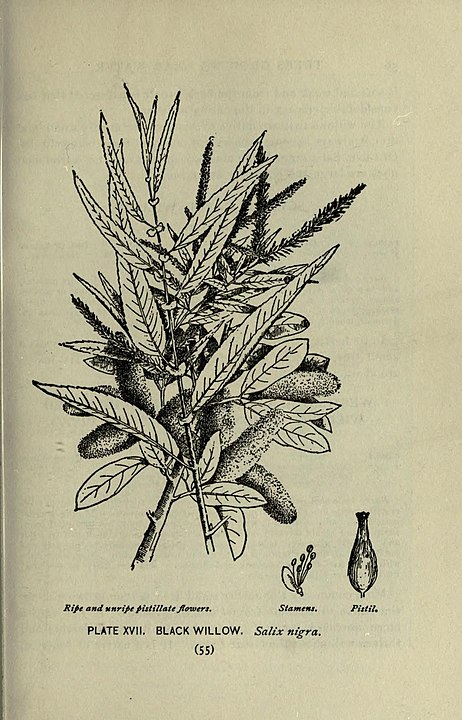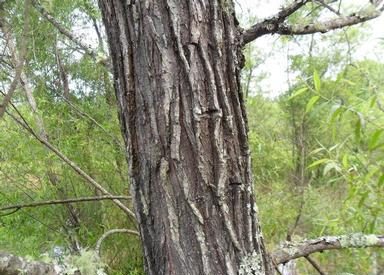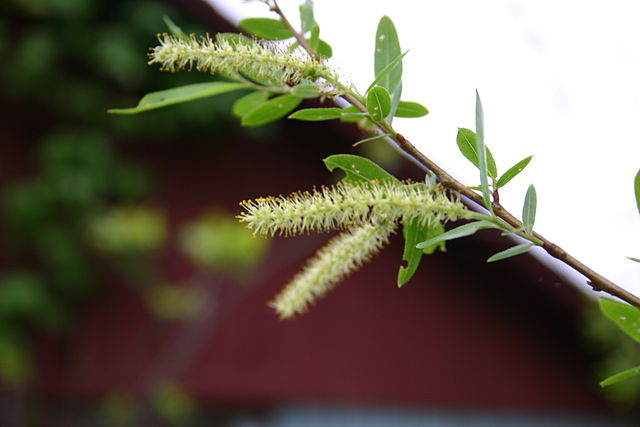
Featured Photo by PumpkinSky / CC BY-SA 3.0
A field guide on how to identify and propagate Black Willow (Salix nigra), a hardy tree that is native to eastern North America.
How to Identify Black Willow (Salix nigra)
Leaves

Black willow leaves are lance-shaped, with serrulate margins, and grow on the stems in alternate arrangements.
Bark

Black willow bark is dark grayish-brown in color and has a deeply furrowed, scaly texture.
On some trees, the bark is quite easy to peel in long strips.
Catkins

Leafy shoots have catkins which are 4-5 cm in length and have many small, yellow-green flowers without petals.
Flowering Season
You can spot the catkins on black willow trees during early spring.
Habitat
Black willow trees are typically found in wet, low-lying areas such as swamps, streambanks, and along the edges of rivers and lakes.
Some plants & trees that associate with black willow are:
- Eastern Cottonwood (Populus deltoides)
- Red Maple (Acer rubrum)
- Black Spruce (Picea mariana)
- Red Mulberry (Morus rubra)
Wildlife Value
Black willow is eaten by birds (buds and flowering catkins), deer (twigs and leaves), rodents (bark and buds), and the yellow-bellied sapsucker (sap).
Additionally, black willow/cottonwood stands are used as nesting habitats by some small nongame bird species. The species is somewhat tolerant of grazing and browsing.
How to Propagate Black Willow (Salix nigra)

Hardiness Zone: 3-9

Soil Type: Clay, loam, sand.

Water: Normal to High.

Exposure: Full Sun to Partial Shade
You can propagate black willow with two effective methods:
- Stem Cuttings: Willows are incredibly easy to propagate by taking stem cuttings, you can even do it in water.
- By Seed: Willow seeds are small and hard to collect, it’s almost always better to just propagate by cuttings instead.
Since cuttings are quite easy with willow, that’s really the best method to use for propagation.
Let’s see how to do it:
How to Propagate Black Willow (Salix nigra) by Cuttings
Your best bet to propagate black willow trees is to take hardwood cuttings. That’s new growth from the previous year that’s gone partly hard.

You can harvest black willow cutting during fall or early spring every year.
Very important: Choose a young, healthy plant to take cuttings from. Older trees lose their ability to regenerate over the years.
How to harvest:
Step 1: Harvest the Cuttings
- First, find branches that are new growth from the previous year, they should be still on the green side. Note: You can take a whole branch and make multiple cuttings from it.
- Snip the branch just below a node, and make sure the width of the cutting is not too thin, 1/4″ to 1/2″ width each is fine. Thick cuttings also work.
- Trim any forking branches from the main stem, then cut your branch into cuttings 6-8 inches long each. Each cutting can have multiple pairs of nodes, as long as the bottom cut is just below the node.
Step 2: Root the Cuttings
Black willow cuttings will easily root in water, here’s how you can do it:
- Place your cuttings into some mason jars with 2-3 inches of water in them.
- Make sure the cuttings are the right way up and look closely at which way the leaf nodes are growing to make sure they’re not upside down.
- Place the cuttings in a spot with indirect sunlight, not shady but not right into bright sunlight.
- Black willow cuttings should root within 2 weeks, after this you can transplant them into regular potting soil.
Wait until your willows have built visible roots, then transplant them into individual pots so they can establish their roots.
Note: Make sure to remove any leaf bud that will be sitting below the soil level. Push about half of the cutting under the soil.
Recommended Soil Mix: Compost, sand, or peat. No need to fertilize at this stage.
From this point, always keep your soil moist. Avoid the roots from drying out as this will kill the cuttings. Water them every day for the first 2 weeks, then reduce watering to every 2-3 days.
FAQ
Q: What is the difference between a weeping willow and a black willow?
A: The key difference between a black willow and a weeping willow is that the former has thicker branches that spread outward, while the latter’s branches are thin and droop down toward the ground.
Q: Can you grow willow from seed?
A: Yes you can harvest black willow seeds during early spring, but they are fluffy and easily fly away in the wind. Willow naturally has rooting hormones, so using cuttings is much easier and faster.
Q: How long does it take a black willow tree to grow?
A: If proper care is taken of an established black willow tree, it can grow up to 4 feet (1 m.) annually.
Q: Is black willow wood good for anything?
A: You can make baskets, furniture, carvings, utility wood, crates, and other small wood specialty items with black willow wood.
